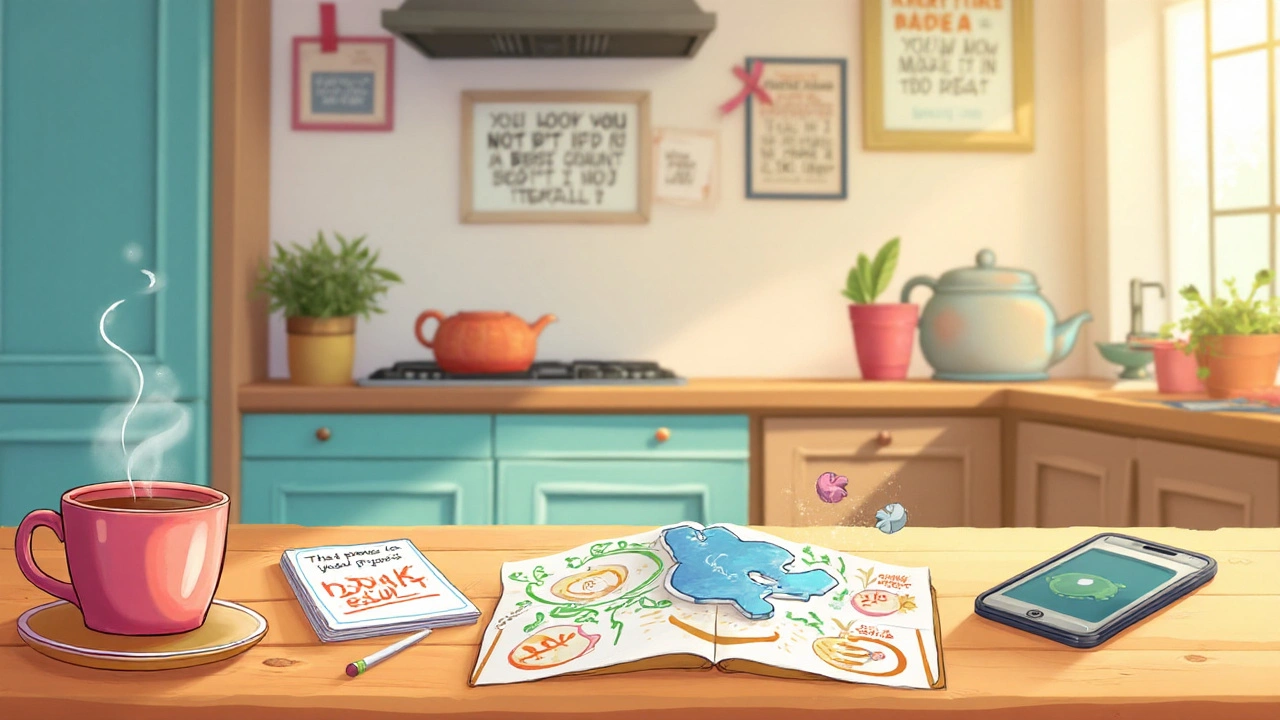
You know that feeling when you’re stuck, swirling around with too much in your head, and it seems like getting help is harder than climbing a mountain in flip-flops? Talking about mental support isn’t exactly the kind of thing anyone grows up learning, like brushing your teeth or tying shoes. There’s this weird space between knowing you need help and actually reaching for it, where shame or confusion can make everything heavier. But here’s the thing—not only is it possible to get real support, it’s not nearly as complicated or scary as it seems. The fact is, around 1 in 4 people in the UK deal with a mental health problem every year, according to Mind. That’s not some tiny club; it’s everyday people everywhere. So if you’re lost, ignoring it won’t make it shrink. Let’s talk about how you can get the kind of support that actually makes a difference, even if you aren’t sure where to start.
Why Mental Support Matters Now More Than Ever
The past few years tossed everyone into some kind of mental spin cycle. There were the lockdowns, the economic worries that seem to never end, and social connections got weirdly shaky. Survey after survey—like the 2024 NHS Digital survey—shows stress, anxiety, and depression are carving out a bigger slice of daily life. Cost of living pressures and social media “perfect” moments might look harmless, but they’ve actually made self-esteem and loneliness real issues for every age. It’s no longer about just “bouncing back.” The truth is, strong mental support can restore you, and sometimes, it’s literally life-saving.
Even sports stars and celebrities now talk openly about depression or anxiety. When someone like Prince Harry shares that he struggled with panic attacks for years, or Simone Biles chooses her mental health over Olympic medals, that’s a loud signal: nobody’s immune. The pressure cooker’s on for teens especially, with over half saying they’ve felt “overwhelmed” in the last year, according to a 2025 YoungMinds report. So, whether you’re facing work burnout or the long shadow of old trauma, support isn’t a luxury—it’s as basic as water or sleep.
There’s this stubborn myth that only people with “serious” problems need to reach out. But let’s get real—mental health swings from little stressors to big, shadowy stuff. Support gives you tools, not labels. Seeking help doesn’t mean you’re weak or broken. It means you’re tired of carrying things alone, which is as human as it gets. With more resources available than ever, and some clever tech thrown into the mix, getting support is less about doors slamming in your face and more about finding the right one to open. That can mean anything from texting a friend at midnight to speaking with a professional who’s trained to listen and guide.
Recognising When You Need Help (Even If You Hate Admitting It)
You’d think asking for help would be easy, but most people are little experts at convincing themselves to wait ‘one more week.’ The signs aren’t always neon bright. Maybe you’re having trouble sleeping, or work feels like wading through mud. You might snap at people for nothing, or find yourself zoning out in the shower, unable to focus. Sometimes, your body says it for you—headaches, stomach aches, or just never feeling rested even after eight hours’ sleep. It’s not always tears or panic attacks. Sometimes it’s just a quiet sense of “something’s not right.”
If thoughts race at bedtime, or you’re replaying mistakes from years ago, that’s your mind waving a little SOS. The real trick is to pause and check in with yourself. One small test: If you’d tell your best friend to get help if they felt the way you do right now, that’s your answer. Another sign? When the stuff you used to love—music, reading, a pint with friends—starts feeling flat or pointless, it’s time to take those feelings seriously. The NHS has a quick self-assessment tool that’s actually pretty good for spotting early signs of depression or anxiety. The stigma used to be brutal, but now, not getting help is more likely to raise eyebrows than actually reaching out.
If you keep putting on a brave face (I’m guilty of this too), you risk sliding into worse territory. Oscar, my partner, never looked under the hood until his “just tired” turned into real panic. It took a nudge and a slightly embarrassing conversation with his GP, but he ended up relieved. Don't wait until you're in crisis. Just like you wouldn’t wait until a toothache becomes an abscess, your mental state deserves quick, honest action. Remember, it’s not about being dramatic—it’s about being honest.

How to Reach Out: First Steps and Real-World Tricks
So, you want help. The first move is always the clumsiest, but here’s where to start. If you feel comfortable, reach out to someone you trust—a friend, a family member, or even that surprisingly easy-going colleague. You don’t have to give them your life story, not at first. Try something simple: “Hey, I’ve been struggling lately, do you have a minute?” or “I could use someone to talk to. Are you free?” Simple, direct, and no need for a grand confession.
If talking is hard face-to-face, jot your feelings in a message or write a letter (old-school works). Sometimes, just giving words to your worry shrinks it a bit. Your support doesn’t have to be a hero with endless wisdom—they just need to be someone who listens without judging. In fact, studies at King’s College London found that talking to peers reduces stress by as much as 50%, so don’t underestimate your social circle.
- Mental health helplines—like Samaritans (116 123) or Shout (text 85258)—don’t care if your story is “big enough.” You can call or text them when it’s 2 AM and nobody’s around.
- Check out the NHS Every Mind Matters page—it covers anxiety, stress, trouble sleeping, and advice for supporting others, too. The best part? You don’t need a referral, and it’s all online.
- If your GP feels daunting, you can book a double-slot to take the pressure out of rushing.
- Local charities or mental health hubs often offer drop-in sessions. You don’t need to “qualify”—just show up and say you’re struggling.
- Some companies include Employee Assistance Programs in your benefits. You might be entitled to free therapy sessions or specialist guidance—ask HR, even if you haven’t told them specifics.
- Don’t rule out digital platforms—apps like Kooth (for young people) or BetterHelp (for adults) connect you with therapists and peer support, sometimes even for free.
For folks who don’t want to talk (or just can't yet), creative outlets can help—journaling, music, painting, baking, even gaming. Sometimes, connecting around a shared hobby instead of your feelings is the “in” you need. And don’t forget, if someone brushes you off, seek out another ear. Support is a numbers game—the more lines you cast, the likelier you are to find the right person or service.
Where to Find Professional Mental Support (And What Really Happens)
Maybe you’ve hit a wall, and friendly chats aren’t enough. That’s where professionals step in. Booking a GP appointment is a classic route, but the NHS now offers self-referral for talking therapies (IAPT, if you want to know the jargon). You don’t have to go through your doctor; you can refer yourself online if you live in England. Appointments might take a while, but getting on a waiting list is better than not being on one at all.
Seeing a therapist isn’t like the movies—no endless armchairs, and plenty of therapists mix chatting and practical skills. Cognitive Behavioural Therapy (CBT) is one of the most common, and NHS stats for 2025 show over two-thirds of people who complete CBT report a massive improvement. There’s also psychodynamic therapy, EMDR (especially for trauma), and group therapy if you find strength in numbers. Private therapy is quicker, but costs can be steep—however, many therapists now offer sliding scale fees, student rates, or shorter, focused sessions. Sites like the British Association for Counselling and Psychotherapy (BACP) let you search for accredited specialists in your area.
If things feel urgent, Accident & Emergency or mental health crisis teams are there (even if your brain says you’ll waste their time—they deal with this all day long). For those feeling unsafe, or dealing with suicidal thoughts, services like the CALM helpline or Papyrus for young people step in fast. There’s no shame in it—sometimes, support means just surviving the bad days, and then building tools when it’s less stormy.
- Child & Adolescent Mental Health Services (CAMHS) cover under-18s. If your teen is struggling, you can self-refer or go through a school nurse.
- Some pharmacies now host quick mental health drop-in services. No appointment, no pressure.
- Online video therapy is now common, and for those with social anxiety, this can be a game-changer.
- Bilingual or culturally aware therapists are available; if you need, ask for it. Language or culture should never be a barrier to help.
- Men’s Sheds, book clubs, and walking groups aren’t just hobbies—they often double as unofficial support groups, especially for men who feel awkward about “talking feelings.”
Don’t brush off medication, either. Sometimes, talking helps, but medication can stabilize things enough to let you do the work. GPs are usually careful, and you get regular check-ins. Even creative therapies—like art therapy, drama, or even animal-assisted therapies—are on the rise, and they’re more evidence-backed than you might think. Basically, you’re spoiled for choice, and there’s no “one right fit.”

Building Ongoing Support—Keeping Going When Life Gets Messy
Getting support isn’t a one-time fix. The world loves a good “breakthrough” montage, but in reality, it’s slow, messy, and sometimes boring. You’ll have good weeks and backslide weeks. That doesn’t mean you’re failing; it just means you’re human. Building habits is the secret sauce. Regular check-ins with yourself (journaling, tracking moods in an app, or just a calendar emoji system) keep things from spiraling quietly. If you get therapy, jot down one thing you learned after each session. It doesn’t have to be deep—sometimes it’s just “Remember to breathe in traffic.”
Find your “team.” Maybe it’s two mates, or an online forum, or your partner who’s rubbish at advice but great at hugs. Support groups sound intimidating, but groups like Anxiety UK or Mind run casual, friendly Zoom calls—no one’s forced to talk, but lots end up sharing more than they expected. Accountability buddies work for workouts and for mental health, too. Oscar reminds me to eat and get outside when anxiety threatens to flatten me, no matter how annoying it feels in the moment.
The workplace has shifted, too. Mental health days aren’t a dirty secret anymore. More companies now offer “wellness hours” or anonymous check-in apps. The Mental Health First Aid (MHFA) program trained more than 35,000 people in the UK by mid-2025, making it way more likely someone in your workplace gets what you’re going through. And don’t forget your GP or therapist; even after initial treatment, it’s wise to keep an annual “mental MOT.”
If you’re struggling long-term, your needs might change. Maybe you outgrow your old support system or discover new challenges. That’s normal. There’s nothing wrong with changing therapists or switching up routines. Even apps—like Headspace or Calm—renew content regularly so things don’t get stale. And, for anyone with a long-term condition, asking for a Care Plan (through your GP or local mental health service) means regular, structured support, with your needs reviewed at least yearly.
The real trick is making support as normal and non-negotiable as coffee—or charging your phone. If today all you manage is sending one text or spending five minutes in the garden, that’s still a win. Bit by bit, the little routines stack up and those walls come down.